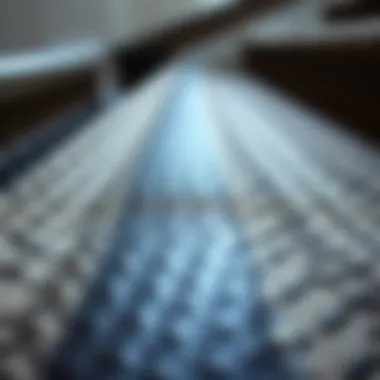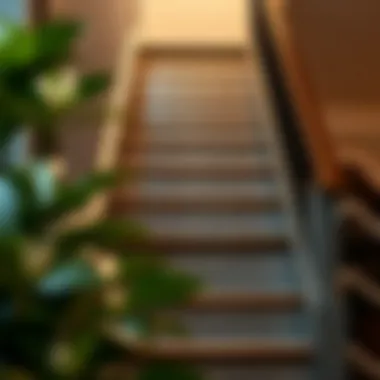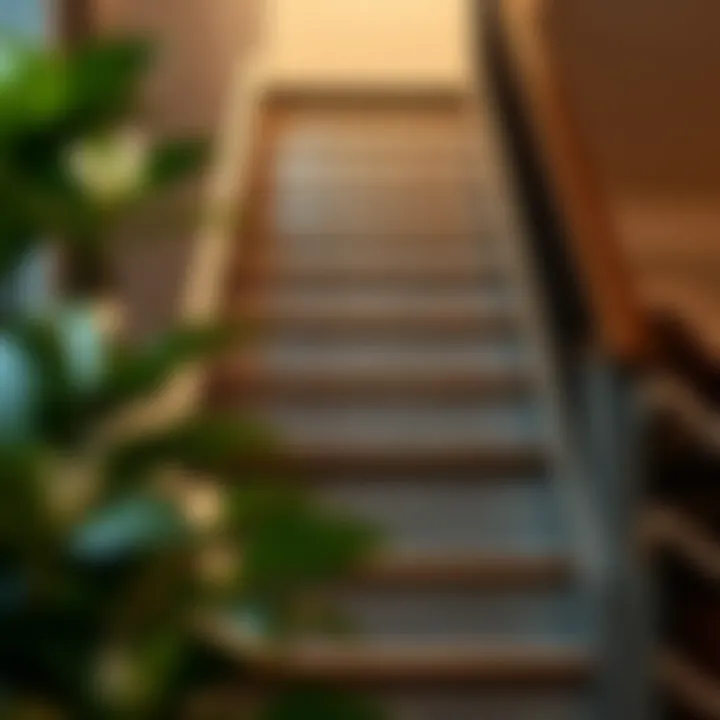Peel and Stick Stair Covers: Blending Style and Function


Intro
Peel and stick stair covers have become a popular choice for homeowners looking to spruce up their interior spaces without taking a sledgehammer to their bank accounts. These innovative products meld functionality with aesthetics, providing an effortless way to refresh tired staircases and add a touch of style.
Many people are drawn to the idea of tackling home improvement projects themselves, and stair covers fit the bill perfectly. Whether you're seeking to enhance the comfort of your stairs, heighten safety with anti-slip materials, or simply update your home’s design, peel and stick covers can cater to a wide range of needs.
This article digs into the qualities that make peel and stick stair covers a go-to solution. From the variety of materials available to practical aspects like installation and maintenance, we aim to provide a thorough understanding of how to effectively utilize these versatile products.
As we navigate the ins and outs of stair covers, expect to explore essential tips and tricks to bring out the best in your staircases, making them not just functional, but also a visual delight.
Preface to Peel and Stick Stair Covers
Peel and stick stair covers have carved a niche in contemporary interior design, providing not just practicality but also an avenue for aesthetic enhancement in homes and commercial spaces alike. With their blend of functionality and style, these products have transformed stairways from mere passageways into focal points of visual interest. The key lies in their adaptability, allowing individuals to elevate their space without the burden of complex renovation processes.
As we dive into this topic, it's vital to understand that the appeal of peel and stick stair covers goes beyond mere convenience. They offer countless design options that cater to diverse tastes, enabling homeowners to express their personality while ensuring safety and durability in areas that experience heavy foot traffic. For fashion enthusiasts and designers, this product presents an opportunity to creatively influence the living environment, merging functionality with personal flair.
In essence, peel and stick technology simplifies the application process, making it accessible even to those without a knack for DIY projects. This approach encourages experimentation with different styles without the commitment of permanent alterations. As we explore the key attributes and benefits of peel and stick stair covers, it becomes clear that their role in home decor is both practical and significant.
Defining Peel and Stick Technology
Peel and stick technology refers to the method of applying adhesive backing to various surfaces, thereby eliminating the need for additional adhesives or tools during installation. This approach streamlines the application process, making it straightforward enough for anyone to handle, regardless of their skill level. The product can generally be applied directly to smooth, clean surfaces, making it remarkably versatile in its use.
Typically, peel and stick stair covers are made from materials such as vinyl, fabric, or even wood, with designs ranging from simplistic patterns to intricate artistic motifs. The adhesive used in these products is engineered to provide a strong bond that maintains its integrity over time while also allowing for removal without damaging the underlying surface. This non-permanence is particularly appealing to renters or those who frequently refresh their decor.
Historical Context and Evolution
The roots of peel and stick technology can be traced back to the mid-20th century when manufacturers began experimenting with self-adhesive products in various forms. What started as a novelty in the realm of wallpaper gradually expanded to include a range of surface applications, including flooring and wall decals. The evolution of material sciences over the decades has vastly improved the durability, aesthetics, and usability of peel and stick items, making them an attractive option for modern consumers.
With the rise of the do-it-yourself movement in recent years, peel and stick products gained monumental popularity. Many homeowners and designers appreciated the ability to customize spaces quickly and affordably, often favoring them over traditional, labor-intensive options. Today, these covers are part of a larger trend that embraces innovation in home improvement, spotlighting the fusion of art and practicality.
"Peel and stick technology embodies a blend of simplicity and style, making home improvement not just achievable but enjoyable."
Thus, understanding the underpinnings of peel and stick technology—not only its definitions but also its historical context—sets the stage for exploring its material considerations, applications, and impact in modern interiors.
Material Considerations for Stair Covers
When it comes to selecting peel and stick stair covers, the material is king. Understanding the material considerations not only enhances the aesthetic appeal of the stairs but also influences the performance, longevity, and overall user satisfaction. This section will delve into the various materials, their advantages and disadvantages, as well as their environmental impact, guiding you to make informed choices when upgrading your stairway.
Common Materials Used
Peel and stick stair covers are primarily made from a variety of materials, each offering unique benefits:
- Vinyl: This is perhaps the most popular option due to its flexibility and resilience. Vinyl stair covers are waterproof, making them perfect for homes with high foot traffic or where spills might occur. Additionally, they can mimic the appearance of wood, tile, or stone without the hefty price tag.
- Carpet: For those seeking a softer touch, carpeted stair covers provide warmth and comfort. They are generally made from synthetic fibers that are easy to clean, though they may require more maintenance in terms of poking up dirt or stains.
- Laminate: This material combines the best of both worlds, providing a wooden appearance without the maintenance woes. Laminate stair covers are durable and less prone to dents and scratches, making them suitable for households with pets or kids.
- Natural Fibers: Some opt for eco-friendly options like jute or sisal, offering a unique texture. However, they tend to absorb moisture and might not withstand heavy wear.
Knowing the pros and cons of these materials helps direct consumers toward the right choice based on their specific needs.
Durability and Wear Factors
One cannot overlook durability when assessing stair covers. While aesthetics draw the eye, enduring wear is what retains a stair cover's appeal over time.
- Resistance: Vinyl and laminate materials typically have built-in resistance to stains and scratches, making them ideal for busy households. They can often stand up to daily wear and still keep their vibrant appearance.
- Maintenance: Carpeted stair covers, while inviting, may require more frequent cleaning to maintain their appearance and hygiene. They tend to trap dust and allergens, which can be an issue for those with sensitivities.
- Longevity: When analyzing the lifespan of different materials, it's notable that vinyl or laminate materials often provide better longevity with lower maintenance needs compared to natural fibers. This can lead to cost savings over time despite a potentially higher upfront investment.
Environmental Sustainability of Materials
Sustainability is increasingly important for today's consumers. With a heightened awareness of ecological footprints, many potential buyers pay attention to the environmental impact of their choices.
- Recyclability: Vinyl and laminate materials can often be recycled, but the processes vary by manufacturer. Consumers are encouraged to research specific brands that prioritize recyclable products.
- Natural Options: For eco-conscious individuals, opting for covers made of natural fibers can provide peace of mind, though these materials may not always be as durable.
- Manufacturing Practices: It's essential to look into the production methods of any materials considered. Many companies strive for sustainability through responsible sourcing and waste reduction.
"When choosing stair covers, remember that your decision can echo beyond aesthetics, influencing longevity and ecological impacts. Choose wisely."
Applications of Peel and Stick Stair Covers
The significance of peel and stick stair covers extends beyond mere aesthetics; they offer practical solutions for both residential and commercial applications. In a world where first impressions count, maintaining a polished and secure stairway becomes essential. These covers are versatile, designed to enhance the beauty of the space while providing safety and durability. From creating a cohesive look in homes to setting the right tone in businesses, understanding their applications can help one appreciate their functional value.


Residential Use
In homes, staircases often serve as central design features. Peel and stick stair covers allow homeowners to express their personality without breaking the bank. They can transform a dull and worn flight of stairs into a vibrant, stylish entryway. The key benefits are numerous:
- Enhanced Safety: Many options include textured surfaces that reduce slipping, a crucial factor for families with young children or elderly members.
- Easy Customization: With designs ranging from bold patterns to subdued neutrals, owners can easily choose a style that complements their existing decor.
- Cost-Effective Renovation: Instead of investing in expensive carpeting or hardwood, these covers provide a wallet-friendly way to refresh the look of a staircase.
For instance, a home with sandy beige walls and oak banisters might benefit from navy blue covers with a geometric design, thus creating an attractive contrast and focal point. This flexibility in design ensures the stairway does not fade into the background but rather enhances the overall ambiance.
Commercial Spaces
In commercial environments, the stakes are higher. Businesses must not only consider the aesthetic appeal but also the functionality and safety of their stairways. The applications of peel and stick stair covers can significantly impact customer perceptions and employee morale.
- Professional Appeal: Offices and retail spaces benefit from cohesive design; proper stair covers are crucial in reinforcing brand identity. For example, a chic boutique could use florals that align with its branding, effortlessly capturing client interest.
- Maintenance of Safety Standards: In public spaces, safety is paramount. Textured stair covers can adhere to regulations while providing a visually pleasing experience. Brands like 3M offer solutions that combine safety with style, making them ideal for high-traffic areas.
- Quick Turnaround: Commercial spaces don't have the luxury of prolonged downtime. The adhesive nature allows for quick installation without the need for professional help, minimizing disruptions and facilitating prompt business operations.
"A well-designed staircase is more than function; it’s a statement of purpose and personality."
In essence, peel and stick stair covers are not just a trend; they are a practical solution that merges design flexibility with the needs of safety and durability, suiting both the personal touches of homes and the polished professionalism of businesses.
Pros of Using Peel and Stick Stair Covers
Peel and stick stair covers have become popular for a good reason. They not only provide practical benefits but also bring a fresh layer of aesthetics to any staircase. Let's dive into the specifics of what makes these covers an attractive choice for homeowners and business owners alike.
Ease of Installation
One of the biggest draws of peel and stick stair covers is the sheer simplicity of installation. Gone are the days when you needed a toolbox filled with an arsenal of expensive equipment. With peel and stick, you essentially just need to clean the stairs, measure, cut if necessary, and then peel off the backing to adhere the cover directly onto the stair surface.
- No Special Tools Needed: Unlike traditional flooring options that may require nail guns, adhesives, or even professional installation, peel and stick covers require little more than your hands.
- Quick Turnaround: Many users report being able to cover an entire staircase in a matter of hours, versus days with more intricate methodologies.
- Minimal Disruption: If you have a busy household or a commercial space, the ability to quickly apply these covers means less downtime and less hassle.
Indeed, the ease of installation is a major selling point that allows anyone to tackle home improvement without the help of a professional. This accessibility empowers homeowners and even renters to make aesthetic changes without significant investment or commitment.
Cost-Effectiveness
When it comes to budget-conscious decisions, peel and stick stair covers hit the nail on the head. Compared to more traditional materials like wood or tile, these covers provide a wallet-friendly alternative without skimping on appearance.
- Affordable Materials: Depending on the brand and design you choose, peel and stick covers often range from inexpensive to moderately priced, allowing you to elevate your space without breaking the bank.
- Reduced Labor Costs: As mentioned, installation requires no specialized labor. Thus, you save on potential installation fees that can range widely, from hundreds to even thousands of dollars.
- Longevity and Value: While the upfront cost is lower, many of these covers are made with durable materials that can withstand foot traffic, which means they can last for years. In other words, this is an investment worth making with long-term savings in mind.
In a world where many home improvements ask for significant financial input, peel and stick stair covers provide a refreshing option that won’t keep you up at night.
Variety of Design Options
Aesthetics also play a crucial role in the popularity of peel and stick stair covers. Many people view their staircase not just as a functional necessity but as an extension of their personal style and interior decor.
- Endless Patterns: Whether you enjoy vibrant designs or subtle textures, there is a myriad of options available on the market. From faux wood to intricate patterns, you can choose the style that resonates with your vision.
- Customizable Looks: For those who may like to switch things up frequently, these covers can simply be removed without damage to the stair surface and replaced with new designs, offering a fresh look on a whim.
- Aligning with Trends: As design trends shift, peel and stick covers offer a flexible means to stay contemporary without a complete renovation. You can follow seasonal trends or enduring aesthetics with minimal effort.
To highlight their versatility, consider this: even if your home boasts different decor styles from room to room, peel and stick covers allow you to create distinct yet cohesive themes throughout, marrying both function and flair.
"The only limit to your design potential with peel and stick materials is your own creativity."
Installation Techniques
Understanding the installation techniques for peel and stick stair covers is essential for ensuring a successful application. Proper installation not only enhances the aesthetic appeal of your stairs but also extends the lifespan of the covers. If the installation is done right, it can save a great deal of time and money down the line.
Preparation of Stair Surfaces
Before diving into the installation process, preparing your stair surfaces is non-negotiable. Here are some key steps to ensure that your stairs are ready:
- Clean Thoroughly: Start with a clean slate. Sweep away dust, dirt, and debris with a broom or vacuum. For stubborn grime, a more thorough wash with soapy water may be necessary. Ensure that your stairs are completely dry after cleaning.
- Check for Damage: Inspect the stairs for any scratches, dents, or unevenness. If there’s any significant damage, fix it before applying your stair covers, as imperfections can affect the adhesion.
- Dry Surface: Moisture can ruin the adhesive quality of the covers. Wait for any cleaning solutions to evaporate completely. A dry surface is key to making sure your stair covers stick like glue.
Step-by-Step Installation Process
- Measure the Stairs: You can’t cut corners—measure each step accurately to obtain the dimensions of your stair covers. It’s advisable to have extra material on hand for miscalculations.
- Cut the Stair Covers: Using a utility knife, trim the covers as needed according to your measurements. Precision here is crucial to ensure a perfect fit.
- Peel and Stick: Start at one end of the step. Carefully peel away the backing of the cover just as you might peel off a label. Align the cover with the edge of the step, pressing down firmly as you lay it in place. You can press down from the center outward to eliminate air bubbles.
- Trim Excess: Once firmly in place, if any material hangs over the edge—feel free to trim it with a utility knife. Just be careful not to cut into the actual stairs.
- Repeat: Proceed with the remaining steps until all are covered. Patience is key here!
Common Mistakes to Avoid
While peel and stick covers are user-friendly, it's easy to make missteps along the way. Here are common pitfalls:


- Skipping Surface Prep: Many rush into installation without a proper clean-up. This is often the culprit of poor adhesion that leads to premature peeling.
- Poor Measurements: Not measuring twice can lead to the headache of mismatched covers. Ensure that you have the right dimensions to avoid wastage.
- Ignoring Temperature: Installing in extreme temperatures can affect the adhesive. Ideally, do this when it’s moderately warm. Cold temperatures can cause the stick to fail.
- Not Taking Your Time: Rushing through can lead to air bubbles or misalignment. Take your time to ensure everything is perfectly in place.
By keeping these installation techniques in mind, you can maximize the functionality and aesthetics of your peel and stick stair covers. With a bit of careful preparation and awareness during installation, your stairs can become impressive features in your home.
Maintenance of Stair Covers
Maintaining your peel and stick stair covers goes beyond just cleaning; it's about ensuring longevity and aesthetic appeal. Regular upkeep can extend the life of these stair covers, keeping them looking fresh and new. Neglecting maintenance can lead to issues such as peeling or wear, which can diminish the overall aesthetic and functionality of your staircase.
Cleaning Recommendations
To keep your stair covers in top shape, it's crucial to adopt a regular cleaning regimen. Here are some practical tips:
- Use a Soft Broom or Vacuum: Start by removing debris such as dust and dirt. A soft broom or a vacuum attachment can effectively get rid of loose particles without damaging the surface.
- Damp Cloth for Spots: In case of spills or stains, use a damp cloth with mild soap. Avoid harsh chemicals that might degrade the adhesive properties over time.
- Rinse Thoroughly: After applying soap, ensure you wipe down with a clean damp cloth to eliminate any residue that could cause slipperiness.
This simple yet effective cleaning method not only helps in maintaining the visual appeal of your stair covers but also enhances traction, reducing the risk of slips.
Lifespan and Replacement Indicators
Even high-quality peel and stick stair covers will have a finite lifespan, typically ranging from five to seven years, depending on several variables including foot traffic and exposure to elements. Here are some signs indicating it may be time for a replacement:
- Visible Wear and Tear: If you start noticing scratches, dents, or fading in colors, it’s time to consider replacing them.
- Peeling or Lifting Corners: Check to see if the edges begin to peel away. Loose corners not only look bad but can also pose a safety hazard.
- Stains That Won't Come Clean: Sometimes, stains might become persistent. If cleaning no longer helps, this is a signal to think about a replacement.
Taking these indicators seriously ensures your stair covers not only serve their purpose but also contribute positively to your home's overall aesthetic.
"Regular maintenance saves money in the long run by extending the life of your stair covers."
Maintaining your peel and stick stair covers isn't just an afterthought; it’s a fundamental aspect of preserving your investment.
Design Considerations
When it comes to making a visual statement in your home, design is everything. The significance of thoughtfully chosen design elements in peel and stick stair covers cannot be overstated. These covers serve dual purposes—functionality and aesthetics. It’s not just about dressing up the stairs; it’s about creating a cohesive look that resonates with your overall interior style. Choosing the right color schemes and patterns can elevate the entire ambiance of a space, while also ensuring safety and practicality.
Color Schemes and Patterns
Color choices can speak volumes about a person’s taste and style. When selecting peel and stick stair covers, understanding color schemes is pivotal. Neutral shades like beige or gray evoke a sense of calmness and can make a small area feel larger. Conversely, vibrant hues such as teal or mustard can be eye-catching and inject personality into your home.
Here are a few aspects to consider regarding color schemes:
- Complementing Existing Elements: The covers should engage well with your walls and adjacent furniture. For instance, if your walls are painted a soft blue, a contrasting yet harmonious stair cover in navy with a subtle pattern can tie the room together nicely.
- Seasonal Changes: Selecting versatile colors allows for seasonal décor adjustments. You might lean towards warm colors in autumn and fresh, bright shades in spring, adapting your stair covers accordingly.
- Balancing Patterns: Patterns can either amplify or clash with your space. Stripes can elongate the look of the stairs, while geometric designs can add an artistic touch. It’s essential to balance bold patterns with calmer hues to prevent visual overwhelm.
Integrating with Existing écor
Creating a seamless transition between your new stair covers and existing decor is crucial. A well-designed space tells a story. To achieve this:
- Evaluate Your Surroundings: Look around your home and analyze the elements—furniture styles, wall art, and flooring. This assessment helps in grasping what would work best in terms of color and pattern.
- Accents and Accessories: Incorporating accent pieces—like vases, cushions, or area rugs—can enhance the overall theme. If your stair covers feature a specific pattern, try introducing that pattern subtly in your accessories, fostering continuity.
- Consider Texture: Different materials can add layers to your design. For example, pairing a plush stair cover with sleek, modern railings creates an appealing contrast, making your stairs more engaging.
Integrating peel and stick stair covers with existing décor is about creating harmony and enhancing the beauty of your space. The right design choice can redefine the overall atmosphere, inviting warmth and elegance into your home. It’s not just about making the stairs safe but turning them into a delightful focal point.
Potential Drawbacks of Peel and Stick Stair Covers
Even the most innovative products come with their own set of challenges, and peel and stick stair covers are no exception. While these coverings offer numerous advantages, understanding their limitations is essential for making an informed choice. This segment will explore the significant drawbacks associated with peel and stick stair covers, particularly focusing on adhesive limitations and their suitability for various stair types.
Adhesive Limitations
A major point of concern when it comes to peel and stick stair covers is the adhesive used in their application. These stair covers rely on a specific type of adhesive to bond securely to the surface of the stairs. However, the quality of adhesion can vary significantly across different products.
- Temperature Sensitivity: Many adhesives are sensitive to temperature changes. If the environment is too hot or cold, the adhesive may lose its effectiveness, leading to potential peeling or lifting over time.
- Moisture Issues: In areas with high humidity or moisture, such as basements or near entryways, the adhesive may not perform well. Constant exposure to dampness can weaken the bond, causing the covers to detach unexpectedly.
- Surface Compatibility: Not all adhesives adhere well to every surface. Textured or porous materials may not provide a strong enough grip, resulting in a product that doesn't hold up as it should.
These adhesive-related concerns could undermine the longevity and overall performance of the stair covers, offering less value than anticipated.
Not Suitable for All Stair Types
Another critical point to consider is that peel and stick stair covers are not universally applicable. Their effectiveness can be hindered based on the design and material of the stairs.


- Curved or Irregular Stairs: Stairs that aren't perfectly straight can be challenging for peel and stick covers. The flexibility needed to adapt to curves or angles may not be present, leading to poor aesthetic results or increased risk of wear and tear.
- Unfinished Wood or Textured Surfaces: For those with raw wood steps or deeply textured surfaces, adhesion can be a struggle. The irregularity can make it difficult for the adhesive to create a solid bond, and in the end, this can lead to complications like slippage or loose edges.
- Heavy Traffic Areas: Stairs that experience high foot traffic may not benefit from peel and stick options, as they can wear down quicker than more traditional materials like carpet or wood. Areas with heavy usage require more robust solutions that can stand the test of time.
Comparing Peel and Stick with Traditional Stair Covers
The debate between peel and stick stair covers and traditional methods is not just about which looks better. It extends into practicality, costs, and overall functionality. Both options have their merits, but understanding the distinct qualities of peel and stick covers compared to their traditional counterparts can enlighten homeowners and designers alike about the best choice for their needs. This section aims to break down the contrast in costs and aesthetic appeal, elucidating why one might choose one over the other.
Cost Analysis
When pondering over stair coverings, cost plays a pivotal role. Peel and stick covers typically shine in this regard. Often, the upfront cost is considerably lower than traditional options, such as wood, carpet, or tiles. Traditional materials often involve expenses related to professional installation, not to mention ongoing maintenance costs—think cleaning, repairs, or even replacement if wear and tear takes its toll.
Peel and stick options, however, are designed for the DIY enthusiast. Installation is straightforward, saving on labor costs. For instance, purchasing a decent-quality peel and stick stair tread can cost around $30 for a set, while traditional carpet could reach upwards of $100 for the same stairway, not including installation fees. The ease of replacing a damaged peel and stick cover also adds to its economical appeal.
"With just a bit of patience and the right tools, even the novice can achieve professional-looking results with peel and stick compositions."
The long-term financial implications shouldn't be overlooked either. While some traditional options, like hardwood, might last longer if maintained carefully, they can also incur hefty repair bills in case of scratches or water damage. In contrast, the affordability of peel and stick stair covers makes them easier to replace when the time comes. No need for elaborate expenditures—it is often more feasible to simply swap out a single tread when needed.
Aesthetic Impact
Peel and stick stair covers have come leaps and bounds when it comes to aesthetics. Although they once had a reputation for being solely utilitarian, modern designs feature a wide variety of patterns, colors, and textures that can seamlessly integrate into almost any décor. From a bold geometric pattern to a simple wood grain, the choices are endless, allowing for an array of personalization options that can fit easily into one's home style.
On the flip side, traditional stair coverings are also available in a multitude of designs, but the installation often limits flexibility. Once installed, any change in aesthetics requires considerable effort and expense. Moreover, traditional carpets may fade or wear unevenly, revealing patches of worn areas sooner than preferred, while peel and stick options allow easy updates that can match evolving trends.
Furthermore, peel and stick installations often maintain their vibrancy longer due to their materials, which are often treated to resist fading and stains. Homeowners can achieve the look of high-end flooring for a fraction of the cost, which is particularly appealing in high-traffic areas.
In summary, comparing peel and stick covers with traditional alternatives unveils glaring differences in both cost and aesthetic potential. Cost-effectiveness and design flexibility position peel and stick options as an attractive choice for many looking to elevate their home environments without breaking the bank.
Consumer Preferences and Trends
The selection of stair coverings, especially peel and stick options, is influenced by an intricate blend of consumer preferences and modern design trends. These choices are not merely functional; they reflect evolving aesthetic values and practical needs among consumers. As homes embrace more personalized decor styles, understanding these preferences becomes essential for manufacturers and retailers aiming to cater to their clientele.
Peel and stick stair covers answer a demand for accessibility and style in one neat package. They allow homeowners to transform their staircases without the hassle of intricate installation processes or hefty costs associated with traditional coverings. In essence, they're about making an impactful statement while ensuring safety and durability — two anchors for modern living.
"Embracing peel and stick technology in home design showcases a shift towards simplicity and personalization, allowing individuals to express their unique styles effortlessly."
Survey of User Experience
A thorough exploration into user experiences offers insight into consumer demographics and highlights why peel and stick covers have surged in popularity. Recent surveys reveal a few key trends:
- Installation Ease: Many users appreciate the straightforward application process. A simple peel-and-apply method resonates with those who often take on DIY projects. Many respondents, particularly millennials, said they would rather invest time in enhancing their space than in complicated installations.
- Variety and Customization: User feedback showed that consumers are enchanted by the breadth of designs available. Stripes, florals, and even faux-wood finishes cater to diverse aesthetic preferences. This flexibility encourages homeowners, especially renters, to customize their spaces without permanent alterations.
- Performance and Longevity: Experiences regarding the overall durability of the products varied. While some noted satisfactory performance and resilience against wear and tear, others encountered issues like lifting at the edges and fading over time. Such feedback emphasizes the need for manufacturers to constantly improve product quality while educating consumers about proper maintenance.
The preference for peel and stick solutions also reflects an increasing awareness of home aesthetics among younger generations, who prioritize visual impact alongside functionality. Knowing what consumers think and feel allows businesses to adapt quickly to meet the ever-evolving landscape.
Emerging Trends in Design and Functionality
As we look into the horizon of interior aesthetics, certain trends around peel and stick stair covers emerge vibrantly:
- Natural Materials and Patterns: There’s a growing inclination towards designs mimicking natural materials, like stone or textured wood. This trend aligns with the wider home and lifestyle movement that prioritizes organic, earthy results over synthetic ones. Think rustic charm meeting modern convenience.
- Bold and Geometric Prints: On the other hand, a penchant for playful graphics is popping up. Energetic geometric designs and vibrant hues appeal to those keen to make a bold statement. This trend is embraced by younger homeowners eager to infuse their environments with personal flair.
- Eco-Conscious Choices: As sustainability becomes a significant factor in purchasing decisions, many consumers are looking for eco-friendly options, including peel and stick covers manufactured from recycled materials or non-toxic adhesives. Brands that highlight their commitment to sustainability could see enhanced loyalty and appeal among environmentally-conscious buyers.
- Smart Technologies: The incorporation of technology into home design is a rising trend. Peel and stick stair covers that incorporate anti-slip technology or special features like ease of cleaning will likely attract attention, marrying form and function in an appealing way.
Industry professionals, including stylists and retailers, need to be aware of these trends to not only satisfy current market demands but also anticipate future developments. Thus, staying ahead of consumer trends is more than a guideline; it’s critical for success in the evolving realm of home decor.
The End
As we wrap up this exploration of stair covers, it’s clear that these versatile decor elements hold substantial promise for both functionality and aesthetics. The conclusion of our discussion underscores a few essential elements that make peel and stick stair covers a worthy consideration for any space.
First and foremost, the ease of installation cannot be overstated. Unlike traditional stair coverings that require professional installation, the peel and stick variety allows homeowners and businesses to enhance their spaces without breaking the bank or lifting a finger beyond the act of applying the cover itself.
Secondly, the vast range of designs available caters to various tastes, making it an attractive option for anyone looking to upgrade their home or office décor. From bold patterns that make a statement to subtle designs that blend seamlessly with existing décor, there is something for everyone. This adaptability is especially important in today's ever-evolving design landscape, where individual expression in living spaces matters more than ever.
Finally, the environmental considerations surrounding the materials used in these covers are increasingly relevant in a world becoming more attuned to sustainability. Many brands are now offering environmentally friendly options, which speaks to a larger movement towards conscientious consumerism. Overall, these factors reveal that peel and stick stair covers are not just a passing trend but a functional and aesthetic choice that aligns with modern living.
"Peel-and-stick stair covers represent a confluence of convenience, creativity, and conscientiousness, appealing to a spectrum of consumers eager to blend style with sustainability."
Summary of Key Points
- Installation Simplicity: A key advantage of peel and stick covers is their straightforward application, making them accessible for DIY projects.
- Design Diversity: An extensive array of colors, patterns, and textures caters to any taste, enhancing the aesthetic appeal of stairs.
- Eco-Friendly Options: More brands are recognizing the need for sustainable materials and production processes, making these covers appealing to environmentally aware consumers.
Future Directions
Looking ahead, the future of peel and stick stair covers may lead to even more innovative solutions. With the increasing focus on sustainability, we might see advancements in material technology allowing for longer-lasting, more eco-friendly options. The trend of customizable designs may also take center stage, enabling consumers to personalize their covers in a way that fits not only their style but also their particular space.
Moreover, as smart homes become more common, integrating technology into home accessories could result in peel and stick stair covers with interactive capabilities—think lighting that adjusts based on foot traffic or even customizable patterns that change with a swipe on a phone app. The potential for growth in this area is vast and exciting, indicating that peel and stick stair covers are likely to become a staple in future design considerations.















